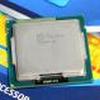Final words and conclusion
Final words and conclusion
Ivy Bridge is the next logical step for Intel to make in terms of their Tick-Tock model. The Tick here is to further improve on the existing architecture, yet on a smaller fabrication process -- the 22nm transition has been completed.
As sexy as the new processors are some people will be a little disappointed though, the new family of processors (when you focus purely on processor performance) is barely faster than the current Sandy Bridge processors. For example, when compared to the Core i7 2600 or 2700 you will only notice (on average) roughly maybe a 10% performance increase compared to a Core i7 3770. So from that point of view one could say that Ivy Bridge really isn't a life-changer when it comes to desktop processor performance.
However, it is never that simple, as we often see new generic platform differences that matter. In this case with the combination of the 7 series PCH chipset and Ivy Bridge we all of a sudden get PCIe Gen 3.0, and that's a lovely enthusiast feature we all would like to have.
Next to that a good move for Intel was to finally get USB 3.0 support going in their chipset, and so they did. The Z77 motherboards will support 4 USB 3.0 links natively. That means that motherboard manufacturers can more easily implement the feature and hopefully make boards a little cheaper as well.
The biggest improvement however is to be found in the IGP. Going from 12 to 16 shader units with accompanying architecture means that Intel is now able to compete with AMD's Fusion products. However for the top-end SKUs AMD still wins though, they have a mighty sound IGP in their A8-3800 series and already have their next generation ready for Q2/Q3.
Do you need to upgrade if you have a Core i5 2500 or Core i7 2600/2700 processor? Well, my advice would be no -- not really. With a 5% to 10% performance differential you will never notice the difference.
It's a little different if you are an overclocking enthusiast though, the ease with which we overclocked the K model 3770 was impressive. You'll reach 4.7~5.0 GHz real fast, even on air based cooling. Be advised though, the Ivy Bridge processors will get hot real fast. You'll need very good cooling to achieve 5 GHz with acceptable temperatures. We noticed that once you pass 1.40 Volts on the processor, heat becomes an issue real fast. The overclocks themselves are grand though.
That, combined with a 77 Watt power draw and lower voltage requirement when overclocking might push you over to the other side. But clock for clock performance, really things are not at all different.
If you are coming from much slower processors and are in need of an upgrade then I can recommend Ivy Bridge very much.
The Core i7 3770K well, this processor I like very much. The processor does seem to have all the variables right, despite the fact we had been hoping for a notch more baseline performance.
What about the IGP? Quite honestly, for gaming, you are still looking at little performance for any serious stuff. Flick down and forfeit on image quality and resolution, and things will get better fast. As huge as the overall performance improvement over the last generation IGPs really is, it remains entry-level for gaming. But for mobile platforms the embedded GPU will be quite good.
We also need to separate gaming from the graphics core, realize that it is a multipurpose graphics processor. You'll have no issues with Blu-ray playback, heck it can even deal with 3D TV, post-process your media files and help out with video en/trans and decoding. The GPU is compatible with HDMI 1.4 and Display Port 1.2 next to the regular DSUB and DVI connectors of course. But overall, we really like the embedded GPU for what it is and does, we like to call it a video or media processor though.
The enhanced AVX extension; I did not expect it to perform this well. You have two requirements before you can use the AVX extension on the processor. Make sure your Windows 7 is up-to snuff with the latest SP1 (required).
The latest revisions of Cyberlink Media Espresso and Arcsoft Media Converter support Intel QuickSync. We have shown you some examples managed with Cyberlink Media Espresso, and a Z77 / 3770K + QuickSync combo, plus a GeForce GTX 680. The feature is going to make a lot of difference this year in upcoming applications, a great new option to have alright. We do need more applications to support it as default though.
Pricing then, Intel increased the pricing difference for the K and non-K models. A 3770 will cost you 278 USD whereas the 3770K will cost you 313 USD, that's a 35 USD difference. Like it or not, we do recommend you get the K series, that's where things start to take off fast if you overclock a little. Remember, we easily reached roughly 5 GHz.
Next in line for the enthusiast will be the 3570K at 212 USD (non K model is 194 USD). This might become the most popular processor, at least we think it will be. The L3 cache is only a hint smaller at 6MB and the default clocks are only 200 MHz lower than the 3770K. You do forfeit on hyper-threading though, the processor as such can be best compared with a 2500K. You can tweak that out of the processor in like 5 seconds. At 212 USD, that's going to be a very interesting processor alright.
Power consumption -- The Intel reference board with a Sandy Bridge processor WITHOUT a graphics card idles at roughly 45 Watts. Once we stress the processor 100% on that platform we leveled out at 110 Watts. So Ivy Bridge and its chipset are energy friendly, however are not at all far off from Sandy Bridge. Once you add a dedicated graphics card the dynamic changes of course. And we also have to mention that with some other motherboards from ODMs like ASUS and MSI, the power consumption was higher. We'll address that in each and every separate review.
Remember, after a BIOS update Ivy Bridge can work fine in your series 6 chipset motherboard as well. Heck, it even works vice versa, a Z77 motherboard will support a Core i7 2700K just as well.
 Right, it's time to wrap things up. Looking at Ivy Bridge in its baseline processor performance we had hoped for a little more. However, the TDP, overclockability, increased IGP performance and then the platform features increase with USB 3.0 and PCIe Gen 3.0 makes the overall infrastructure much more interesting than the previous generation. Coming from Sandy Bridge in the same performance bracket I don't see a need for you to upgrade. But coming from the first generation Core processors, that could make all the difference in the world.
Right, it's time to wrap things up. Looking at Ivy Bridge in its baseline processor performance we had hoped for a little more. However, the TDP, overclockability, increased IGP performance and then the platform features increase with USB 3.0 and PCIe Gen 3.0 makes the overall infrastructure much more interesting than the previous generation. Coming from Sandy Bridge in the same performance bracket I don't see a need for you to upgrade. But coming from the first generation Core processors, that could make all the difference in the world.
The Core i7 3770K might be a little pricey, but for any performance enthusiast in the desktop PC platform we can wholeheartedly recommend these processors and a nice Z77 motherboard.
Please be advised that today the Ivy Bridge series processor are announced, availablility of the processors will start next week on the 30th of April 2012.
- Discuss this product
- Sign up to receive a notice when we publish a new article
- Or go back to Guru3D's front page.

